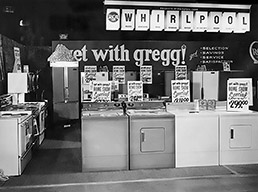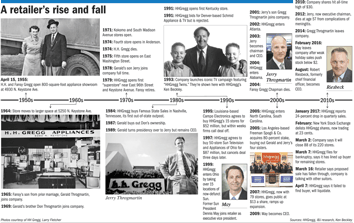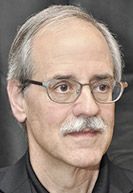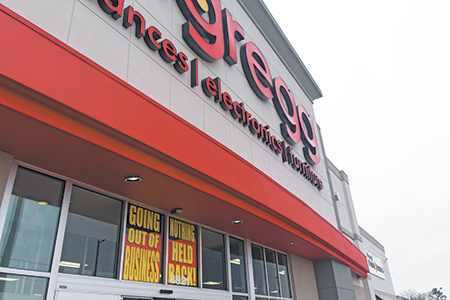Subscriber Benefit
As a subscriber you can listen to articles at work, in the car, or while you work out. Subscribe NowIn the early 1980s, when Detroit-based appliance retailer Fretter Inc. entered Indianapolis and challenged HHGregg on its home turf, HHGregg bought full-page ads in the Detroit newspapers hawking its own merchandise and offering free shipping.
Those were heady days for HHGregg, which built a loyal following in Indianapolis with an unwavering focus on customer service; an army of well-paid, full-time commissioned salespeople; and an avalanche of advertising that resonated with consumers.
It was a winning formula for founders H.H. and Fansy Gregg, who opened the first store at 4930 N. Keystone Ave. in 1955, and for the family members who helped build the chain to more than 200 locations in the decades that followed.
“The customer-first attitude came from Mr. and Mrs. Gregg,” said Ken Beckley, an HHGregg executive from 1983 to 2001 who also was the face of the company’s advertising. “When I was there, we preached to employees that job No. 1 is to take good care of the customer. If you do that, profits will follow. We never put profits first. We put customers first, and it paid off.”
 HHGregg, founded on North Keystone Avenue in 1955, did not open a second location until it branched into Kokomo in 1971. It had 228 stores at its peak. (Photo courtesy of HHGregg)
HHGregg, founded on North Keystone Avenue in 1955, did not open a second location until it branched into Kokomo in 1971. It had 228 stores at its peak. (Photo courtesy of HHGregg)The strategy helped fell a long list of rivals—including Fretter and Highland Superstores Inc., another Detroit chain that dove into Indianapolis in the early 1980s. Both firms later skidded into bankruptcy, with a Highland executive calling Indianapolis its “Death Valley.” In 1998, Circuit City Stores Inc., then a retail powerhouse, arrived in Indianapolis, only to land in liquidation a decade later.
Now, done in by a long list of problems—including overexpansion and a collapse in sales of consumer electronics, once its biggest business—HHGregg is joining the trash heap of failed appliance and electronics retailers.
The company’s demise has been unfolding in slow motion for years, but the final unraveling came with breathtaking speed.
HHGregg announced March 2 that it was shutting 88 of its 220 stores. Five days later, it filed for bankruptcy protection—a move aimed largely at getting off the hook for rent on closed stores—and said it planned to sell itself. But no deal got beyond the letter-of-intent stage, and CEO Bob Riesbeck announced April 7 that the business would wind down this spring, dismissing the last of its more than 5,000 employees.
It’s tough to preside over the closing of a company that was a fixture of the community and had many longtime, loyal employees, said Riesbeck, a turnaround specialist brought in as chief financial officer in September 2014 and promoted to the top job last year.
“That’s the most painful aspect, for sure,” Riesbeck said. “I signed a lot of service-award certificates last week for 30- and 35-year employees. Knowing where we were headed at the time, it was not an easy thing to do.”
Family affair
It might not be a coincidence that the company took a precipitous turn for the worse once there was no longer a member of the founding family at the helm.
The company’s family leadership had distinct chapters. H.H. and Fansy Gregg were simple people without college degrees, said Beckley, who delivered Fansy’s eulogy when she died in 2004 at age 86.
The next generation—Gerald and Don Throgmartin, Fansy’s sons from a prior marriage—joined the company in the 1960s and expanded HHGregg from a single-store business into a regional chain.
Neither Gerald, who spent a decade at Sears before joining the family business, nor Don, had college degrees, either. “But there was something about these two men,” Beckley said. “They operated so much by feel—all based on the experiences they had. They had just wonderful instincts.”
Then there was Gerald’s son Jerry, who began working at HHGregg as a middle-schooler and joined it full time in 1978. Growing up, the younger Throgmartin had dreamed of a professional football career. But when reality set in that it wasn’t going to happen, “I started getting a bug for our business almost as a replacement for the competitive part of football,” Throgmartin said in a 1990s interview.
Jerry Throgmartin’s son Gregg Throgmartin, representing a fourth generation, joined the business in 2001. He started at the bottom, as a salesman at an HHGregg in Nashville, Tennessee, and rose to executive vice president. He was the first HHGregg salesman to crack $1 million in sales in his first year.
Gregg Throgmartin left the company in 2014 and now is an executive at a California fashion company. He did not respond to requests for comment for this story.
It was under Jerry—a University of Indianapolis graduate with an executive MBA from Indiana University—that the company enjoyed its golden age, ratcheting up expansion while remaining true to what had driven its success.
One of the company’s smartest moves, Beckley said, was buying one-minute ads in new markets, such as Cincinnati and Cleveland, to establish a connection with customers. The ads, featuring Beckley in front of the cities’ landmarks, were pricey—manufacturers didn’t pick up any of the costs because the spots didn’t feature products—but paid off.
 Stitle
StitleJerry Throgmartin "always believed in having a well-trained workforce and the importance of the customer,” said Steve Stitle, a veteran Indianapolis attorney and banker who knew Throgmartin for decades. “He really knew how to take care of the customer—he was focused on it.”
Throgmartin was serving as executive chairman of the company when he died unexpectedly in January 2012 at just 57. His family said he was felled by complications from meningitis while visiting his ranch in Colorado.
The company’s fortunes went steadily downhill from there.
Throgmartin had scaled back his involvement in the business three years earlier, passing the CEO’s job to longtime company executive Dennis May. But company observers said May—who resigned in February 2016 after a horrendous Christmas shopping season—was no Throgmartin.
May, now CEO of a locally based provider of pediatric health care services called Hopebridge LLC, did not return calls seeking comment.
Asked whether the company lost something without Throgmartin running the ship, Riesbeck said: “I mean, he was clearly the driver of the business. And I think some of the growth after Jerry was misguided. I think us going into the Mid-Atlantic market—we shouldn’t have done that.”
The problem with the East Coast, Riesbeck said, is that marketing, labor and real estate costs are all higher. “So you put all three of those elements together and it’s just a tougher market.” He added that it also didn’t bode well that many of HHGregg’s stores were outposts for Circuit City before that chain retrenched and ultimately closed.
The company’s plan announced in March to close 88 stores was largely aimed at reversing that decision—refashioning the chain around profitable locations and jettisoning money-losers.
But it came with a steep price. The 88 stores and the three distribution centers that fed them had unpaid lease obligations of $190 million. The company’s decision to file for Chapter 11 was largely driven by its desire to shed those leases.
 Click for larger view.
Click for larger view.Awash in challenges
To be sure, HHGregg would have faced rocky times, no matter what.
The rise of Amazon.com and the lack of TV innovations that have resonated with consumers have combined to commoditize and deflate prices in an industry that once had fat profit margins. Adding to the pain is the reality that flat-screen TVs are now sold in lightweight boxes, reducing the need for HHGregg’s delivery and installation services.
The plunge upended HHGregg’s business model. When the company went public in 2007, it boasted in regulatory documents of “superior store economics”—fueled in large part by consumer electronics, which generated the majority of its sales. In the first nine months of the latest fiscal year, consumer electronics accounted for just 34 percent of revenue.
Riesbeck was racing to adapt by continuing to roll out 4,500-square-foot, super-premium Fine Lines appliance stores—which were performing well. He also had ambitious plans to upgrade the chain’s assortment of furniture, a product line it introduced in 2013. He thought furniture, now just 6 percent of sales, could reach 30 percent.
As recently as two years ago, the company had the good fortune of having no debt. But the financial tourniquet tightened quickly.
After HHGregg’s horrid Christmas in 2015, the company’s vendors began demanding that it pay for merchandise on delivery. It was a big adjustment for a firm that previously had more than $200 million in merchandise credit.
In response, HHGregg thinned inventories and passed over buying some narrow-margin products it previously stocked. The shift helped explain why the company suffered a mind-boggling 39-percent drop in same-store consumer electronics sales in the quarter ended Dec. 31.
The company at first glance appeared to have ample financial breathing room, thanks to a largely untapped $300 million line of credit. But because that line was collateralized by inventory, the amount it was eligible to borrow declined as inventory fell. As of Dec. 31, the company had borrowed $30 million of the $94 million it could draw. Borrowing rose to $56 million by early March.
After HHGregg stumbled through the latest Christmas shopping season, Synchrony Bank, provider of the company’s private-label credit card, escalated the financial pressure by requiring that HHGregg post a $17 million letter of credit. HHGregg opted not do so and dropped the card.
Missed opportunity?
Despite all those challenges, Riesbeck thinks the company should have survived.
It entered bankruptcy with a letter of intent from a prospective buyer—an affiliate of Florida-based Zimmerman Advertising, the company’s advertising agency.
After that deal unraveled, HHGregg expressed optimism it could cut a fresh deal. It had discussions with more than 50 private equity firms, strategic buyers and other investors. People familiar with the discussions say one of them was Gregg Throgmartin, who was interested in buying a swath of stores in historically strong markets but did not come to terms.
To secure agreements with lenders for up to $80 million in bankruptcy financing, HHGregg had agreed to a tight timeline that called for the company to be sold at auction April 24.
That was challenging enough, Riesbeck said. But one of the lenders, Los Angeles-based Great American Capital Partners, tightened the screws further after going-out-of-business sales for the 88 stores got off to a weak start, missing sales projections. It declared HHGregg in default and accelerated the timetable, giving HHGregg only until April 7 to find a buyer.
Adding to the pressure: The sales negotiations were occurring during one of the weakest stretches for brick-and-mortar retailing in decades. Almost daily, another major chain filed for Chapter 11.
“Because of that expedited timetable, several private equity firms just walked away,” Riesbeck said.
“I still believe today in this model,” he added. “I think that the biggest issue was time.”
Asked if he had a beef with Great American, he said, “Could they have been a little more user-friendly? Yeah.”
Great American declined to comment, as did James Doak, managing director of New York-based Miller Buckfire, the investment banking firm that led sale efforts.
Pulling the plug
 Feinberg
FeinbergRichard Feinberg, a professor of consumer sciences at Purdue University, understands how Riesbeck feels. He was on the board of Indianapolis-based Paul Harris Stores Inc. in 2001 when lenders pulled the plug on the 47-year-old, 250-store women’s apparel chain after its second bankruptcy in a decade.
“I was absolutely sure we would have made it,” Feinberg said.
It ultimately came down to a loss of confidence after years of struggle—the same problem that beset HHGregg, which had reported 13 consecutive quarters of losses.
Among those who lost confidence was Brad Leonard, whose Zionsville investment fund sold off its 7 percent stake in the company in January after the disastrous holiday results indicated a turnaround was less likely.
The company could have helped itself by acting earlier to match rivals on free shipping, build a strong online presence, and diversify its product mix away from consumer electronics, Leonard said.
Even so, he said, avoiding those missteps might have only delayed HHGregg’s bankruptcy. With the rapid decline of the consumer electronics category, the company needed to rapidly grow its furniture and mattress business, which has higher margins but also is very competitive.
“Let’s face it,” Leonard said. “It’s a tough business, and the shifting nature of retailing made it more difficult.”
Stitle said it would have been interesting to see how Jerry Throgmartin responded to the challenges were he still alive.
One thing is for sure: He wouldn’t have viewed the failure as inevitable. In numerous newspaper interviews over the years, he said variations of this: “It is my own belief that competition does not put you out of business. You put yourself out of business because you stop delivering what the customer wants.”•
Please enable JavaScript to view this content.

